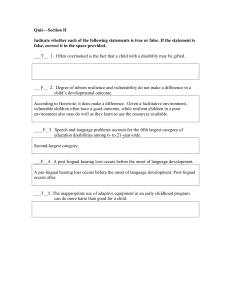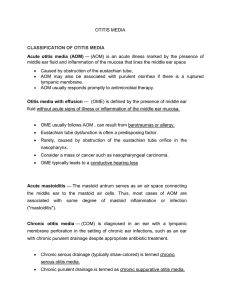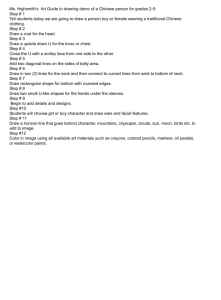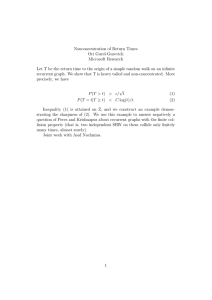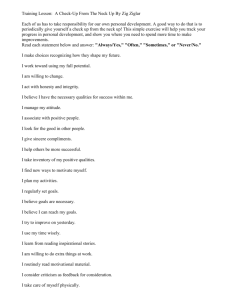Pediatric Otolaryngology Disorders for Primary Care
advertisement
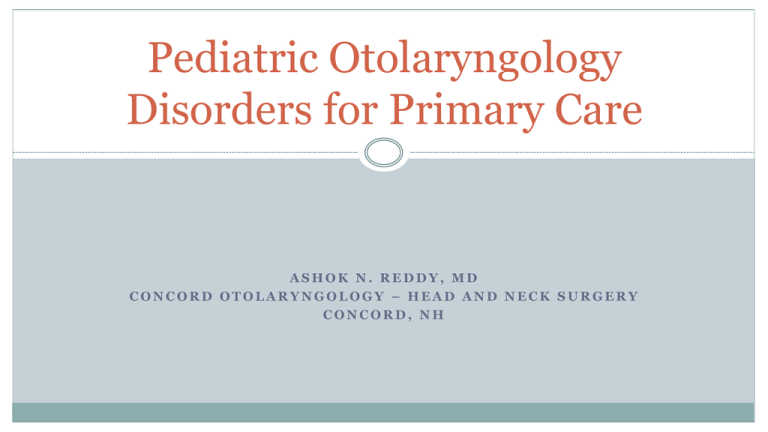
Pediatric Otolaryngology Disorders for Primary Care ASHOK N. REDDY, MD CONCORD OTOLARYNGOLOGY – HEAD AND NECK SURGERY CONCORD, NH DISCLOSURES None of the planners or presenters of this session have disclosed any conflict or commercial interest Pediatric Otolaryngology Disorders for Primary Care OBJECTIVES: 1. Discuss the anatomy and physiology of children of varying ages that predispose them to ENT disorders. 2. Discuss treatment by the PCP for common disorders seen in every day practice. 3. Identify when to refer to a specialist based on poor response to standard treatment or unclear/unusual diagnosis. Otolaryngology Pathology in Children Neck Masses Sleep Disordered Breathing/OSA Pharyngitis Otitis Media/Cholesteatoma Airway Neck Masses Inflammatory masses Congenital masses Branchial Cleft Cyst Thyroglossal Duct Cyst Teratoma Lymphangioma (Cystic Hygroma) Hemangioma AVM Neoplasms Cancer Thyroid goiter/nodule Neck Masses – Work Up History Duration Size trend Pain Fever Constitutional Symptoms Physical Size Erythema Tenderness Firmness Location Neck Masses – Work Up Radiology Ultrasound CT scan of neck with contrast Cons: Less illustrative of anatomy Cons: Radiation exposure MRI with gadolinium Cons: May need general anesthesia Lab tests CBC ESR Bartonella titers PPD Inflammatory/Infectious Masses Palpable LNs in children are common. Differential Diagnosis Reactive LN Lymphadenitis Suppurative lymphadenitis Retropharyngeal or parapharyngeal space abscess “Cat scratch” disease Atypical Mycobacterium Inflammatory/Infectious Masses Reactive LNs Palpable without fixation, redness, tenderness, fluctuance. Management - Watch and wait. Lymphadenitis One or more of the abnormal findings. Consider treating with a strong PCN analog such as Augmentin. Close followup. Consider referral to Otolaryngologist if not improving or appears unwell. Inflammatory/Infectious Masses Symptoms of Suppurative Lymphadenitis/Abscess Large, red, fluctuant. Symptoms of being “sick” Torticollis May not have tonsillitis or other head and neck infection. Management Options Aspiration Incision and Drainage Consider admission to Hospital for IV antibiotics Congenital Neck Masses Branchial Cleft Cyst Incomplete obliteration of a branchial cleft during embryonic development. Lateral Neck mass anterior to SCM. Generally presents with infection. Difficult to distinguish from suppurative lymphadenitis on exam. Ultrasound and CT scan help differentiate it. Referral to Otolaryngologist for excision. Thyroglossal Duct Cyst Incomplete obliteration of tract as thyroid descends from base of tongue to base of neck. Midline Neck mass. Passes through middle of Hyoid bone (above thyroid cartilage) Moves with swallowing. Ultrasound to define mass and ensure normal thyroid gland is present. Sistrunk procedure Body of hyoid bone removed. Head and Neck Cancers in Children No. 1 fear of a parent Rare - 5% of pediatric cancers. Most common Pediatric H&N cancers Lymphoma >50% Rhabdomyosarcoma Thyroid Less common Nasopharyngeal, Salivary gland, Malignant teratoma, other sarcomas, neuroblastoma. Lymphoma Non Hodgkin's Lymphoma More common Peak incidence 7-11 yo Tonsil asymmetry, neck mass Fever weight loss night sweats malaise Hodgkin's Lymphoma Less common Peak incidence 15-20 yo Firm, rubbery neck mass Fever weight loss night sweats malaise Sleep Disordered Breathing (SDB) Abnormal respiratory patterns while sleeping Spectrum Snoring to Obstructive Sleep Apnea (OSA) Snoring: 10%-20% of children OSA: 2%-4% of children Sleep Disordered Breathing (SDB) Children who snore vs. non-snorers have lower scores on tests of * Attention Verbal skills Academic and Executive function Negative effects of SDB in children without OSA* Increased Anxiety Increased Depression scores Increased Social problems Children with OSA have even worse scores.* *Owens JA. Neurocognitive and behavioral impact of sleep disordered breathing in children. Pediatr Pulmonol. 2009;44(5):417-422 *Holbrook CR, et al Neurobehavioral implications of habitual snoring in children. Pediatrics. 2004;114(1):44-49 Sleep Disordered Breathing (SDB) Sleep study is not necessary unless (AAO guidelines) Moderate to severe OSA suspected age <3 craniofacial anomalies Down syndrome Adenotonsillectomy is effective in children. Not as effective in children who have Craniofacial anomalies Down syndrome Moderate to severe OSA Signs & Symptoms of OSA (AAP Guideline) History Snoring > 3 nights/week Labored breathing while asleep Gasping, snorting, witnessed apneas Secondary sleep enuresis Abnormal sleep positions Cyanosis ADHD Learning difficulties Physical Exam Over or underweight Tonsil hypertrophy High-arched palate Hypertension Micrognathia/Retrognathia Mouth breathing Recurrent Acute Pharyngitis Natural History – will resolve on own Paradise Criteria for Tonsillectomy 7 episodes in one year 5+ episodes in each of last two years 3+ episodes in each of last three years Clinical features of an episode: Sore throat + one of below features: Temp >100.9 degrees F Cervical adenopathy (tender LN or LN>2cm) Tonsillar exudate Culture positive for group A Bhemolytic streptococcus Recurrent Acute Pharyngitis Modifying factors – Earlier tonsillectomy Multiple antibiotic allergies Episodes are severe or poorly tolerated PFAPA (Periodic Fever, Aphthous stomatitis, Pharyngitis, Adenitis) Peritonsillar abscess PANDAS (Pediatric Autoimmune Neuropsychiatric Disorders Assoc. with Strep.) Other indications (Must weigh against risks of surgery) Malocclusion Halitosis Tonsillithiasis Febrile seizures Peritonsillar Abscess Symptoms Muffled (Hot Potato) voice Uvular deviation (Asymmetric oropharynx) Trismus Treatment Drainage Oral antibiotics Steroids Tonsillectomy after 2nd episode Ear Pathology Otitis Media Recurrent Acute Otitis Media Chronic Otitis Media Complications of Otitis Media Tympanic Membrane Perforation Spontaneous rupture with AOM Chronic Cholesteatoma Hearing loss Otitis Media Definitions Recurrent AOM >3 separate AOM episodes within 6 months. >4 separate AOM episodes within 12 months with 1 in the past 6 months. Otitis Media with Effusion (OME) Presence of serous or mucoid effusion No AOM Chronic Otitis Media (COM) OME > 3 months Recurrent Acute Otitis Media Pneumococcal Conjugate Vaccine – decreases incidence. Breast feeding – decreases incidence. Prophylactic antibiotic therapy – not effective. Chiropractic therapy – not effective. Recurrent AOM will eventually resolve. PE tube placement (AAO guidelines) Recurrent AOM with effusions present at time of evaluation. Mean decrease of three episodes of AOM per year after PETs. Ability to treat additional episodes with antibiotic ear drops. Chronic Otitis Media OME usually resolves within 3 months. May cause dizziness, hearing loss, discomfort, poor school performance. Minimal effectiveness found with using nasal balloon inflation. PE tubes recommended for OME > 3 months duration with: Hearing loss Other symptoms Speech delay May elect to perform earlier in children with Down syndrome, congenital malformations or other risk factors. Tympanostomy Review Indications: Recurrent AOM with effusion 3 or more episodes in 6 months 4 or more episodes in 12 months Chronic OM > 3 months At risk children Mean decrease of three episodes of AOM per year after PETs. Up to 50% of patients need a 2nd set of tubes Adenoidectomy with 2nd set of tubes Risks - perforation and cholesteatoma Q6 month surveillance. Tympanic Membrane Perforation AOM with spontaneous rupture – perforation will heal with treatment of AOM. Bloody otorrhea or blood in meatus is not a cause for concern. Chronic TM perforation symptoms Hearing loss Recurrent OM Causes Tympanostomy, Trauma Treatment options Myringoplasty – small perforations Tympanoplasty – large perforations Cholesteatoma What is it? Expanding keratinizing squamous epithelial tumor Symptoms Asymptomatic, Hearing loss, Recurrent OM, Chronic otorrhea Etiology Congenital, TM perforation, TM retraction Congenital Asymptomatic “pearl” in intact TM Sensorineural Hearing Loss Congenital Hereditary or maternal infection Acquired Trauma, hereditary, iatrogenic, infection, noise exposure CPA tumor, Pendred syndrome, Jervelle and Lange-Neilsen Syndrome, etc. Treatment options Hearing aids, FM system Cochlear implants Conductive Hearing Loss Middle ear effusion – most common Cerumen TM perforation Cholesteatoma Rare Ossicular chain discontinuity, Aural atresia Treatment options Hearing aids, FM system Surgery Airway Obstruction Nasal Laryngeal Esophageal Symptoms Respiratory distress Stridor, Retractions Drooling/Dysphagia Unilateral rhinorrhea Infection that does not resolve with treatment Airway Obstruction Foreign body Infection URI – RSV, etc. Croup Epiglottitis Trauma Neoplasm Subglottic hemangioma Teratoma Dermoid cyst Congenital Choanal atresia Laryngomalacia Laryngotracheal anomaly Toddlers – Foreign Body Laryngeal, Nasal, Aural, Esophageal Symptoms Sudden Stridor, Unilateral Rhinorrhea, Dysphagia, Drooling, Ear infection Unresolving “Infection” Suspected laryngeal FB is an EMERGENCY. Send to ER Suspected Battery FB is an EMERGENCY Send to ER Nasal/Ear FB Can be handled in office. Infections Epiglottitis – EMERGENCY Fever Drooling Tripodding, Respiratory distress Much less common since Hib vaccine Diphtheria Uncommon Croup Viral Symptom management, May need admission for treatment Neonatal period - Neoplasm Subglottic hemangioma May resolve as they get older. Treated with B-blockers or surgery. Teratoma Dermoid cyst Endoscopy or Imaging Neonatal period - Laryngomalacia Stridor when feeding or lying down Generally self-resolving by Age 2. Fiberoptic laryngoscopy is diagnostic “Floppy” epiglottis and larynx Surgical intervention RARE May be associated with other congenital anomalies Referral to Otolaryngologist for endoscopy Neonatal period – Choanal Atresia Bilateral Life threatening Unilateral Unilateral rhinorrhea Unable to pass catheter through one or both nasal passages. CT scan of sinuses Referral to pediatric otolaryngologist
